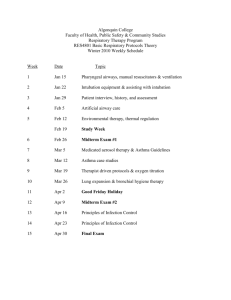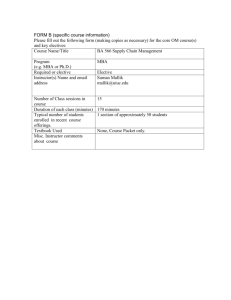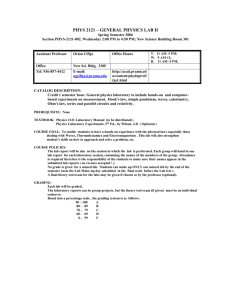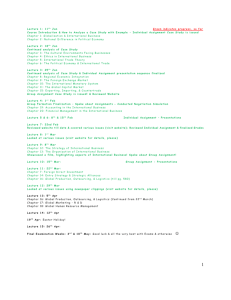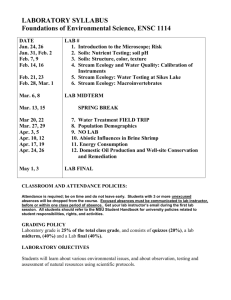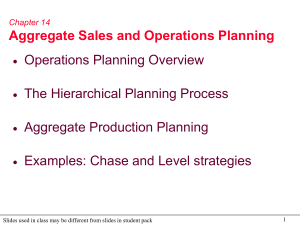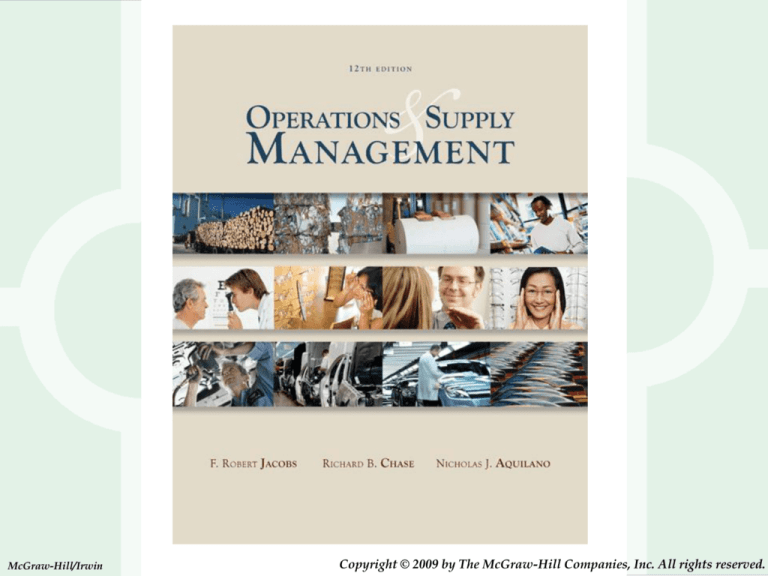
McGraw-Hill/Irwin
Copyright © 2009 by The McGraw-Hill Companies, Inc. All rights reserved.
Chapter 16
Aggregate Sales and
Operations Planning
16-3
OBJECTIVES
• Sales and Operations Planning
• The Aggregate Operations Plan
• Examples: Chase and Level
strategies
16-4
Process planning
Long
range
Supply network
planning
Strategic capacity
planning
Forecasting and
demand management
Sales and operations
(aggregate) planning
Sales
plan
Medium
range
Manufacturing
Master scheduling
Short
range
Aggregate
operations
plan
Logistics
Services
Vehicle capacity
planning
Material requirements
planning
Vehicle loading
Order scheduling
Vehicle dispatching
Warehouse
receipt
planning
Weekly
workforce
scheduling
Daily workforce
scheduling
1-4
16-5
Sales and Operations Planning Activities
• Long-range planning
–
–
Greater than one year planning horizon
Usually performed in annual increments
• Medium-range planning
–
–
Six to eighteen months
Usually with weekly, monthly or quarterly
increments
• Short-range planning
–
–
One day to less than six months
Usually with weekly or daily increments
16-6
The Aggregate Operations Plan
• Main purpose: Specify the
optimal combination of
– production rate (units
completed per unit of time)
– workforce level (number of
workers)
– inventory on hand (inventory
carried from previous period)
• Product group or broad
category (Aggregation)
• This planning is done over an
intermediate-range planning
period of 3 to18 months
16-7
Balancing Aggregate Demand
and Aggregate Production Capacity
10000
Suppose the figure to
the right represents
forecast demand in
units
Now suppose this
lower figure represents
the aggregate capacity
of the company to
meet demand
10000
8000
8000
6000
7000
6000
5500
4500
4000
2000
0
Jan
Feb
Mar
Apr
May
Jun
9000
10000
8000
8000
What we want to do is
balance out the
production rate,
workforce levels, and
inventory to make
these figures match up
6000
6000
4500
4000
Jan
Feb
4000
4000
2000
0
Mar
Apr
May
Jun
16-8
Required Inputs to the Production Planning System
Competitors’
behavior
External
capacity
Current
physical
capacity
Raw material
availability
Planning
for
production
Current
workforce
Inventory
levels
Market
demand
External
to firm
Economic
conditions
Activities
required
for
production
Internal
to firm
16-9
Key Strategies for Meeting Demand
• Chase
• Level
• Stable workforce
16-10
Aggregate Planning Examples: Unit Demand and Cost Data
Suppose we have the following unit
demand and cost information:
Demand/mo
Jan
Feb
Mar
Apr
May
Jun
4500
5500
7000
10000
8000
6000
Materials
Holding costs
Marginal cost of stockout
Hiring and training cost
Layoff costs
Labor hours required
Straight time labor cost
Beginning inventory
Productive hours/worker/day
Paid straight hrs/day
$5/unit
$1/unit per mo.
$1.25/unit per mo.
$200/worker
$250/worker
.15 hrs/unit
$8/hour
250 units
7.25
8
16-11
Cut-and-Try Example: Determining
Straight Labor Costs and Output
Given the demand and cost information below, what
are the aggregate hours/worker/month, units/worker, and
dollars/worker?
Demand/mo
Jun
Jan
4500
Feb
5500
Mar
7000
Apr
May
10000
7.25x2
2
8000
6000
Productive hours/worker/day
Paid straight hrs/day
22x8hrsx$8=$140
8
Days/mo
Hrs/worker/mo
Units/worker
$/worker
Jan
22
159.5
1063.33
$1,408
Feb
19
137.75
918.33
1,216
7.25
8
Mar
21
152.25
1015
1,344
7.25x0.15=48.33
&
84.33x22=1063.33
Apr
21
152.25
1015
1,344
May
22
159.5
1063.33
1,408
Jun
20
145
966.67
1,280
16-12
Chase Strategy
(Hiring & Firing to meet demand)
Days/m o
Hrs/wo rker/m o
Units/wo rker
$ /wo rker
Dem and
Beg. inv.
Net req.
Req. wo rkers
Hired
Fired
W o rkfo rce
Ending invento ry
Jan
22
1 5 9 .5
1 ,0 6 3 .3 3
$ 1 ,4 0 8
Jan
4 ,5 0 0
250
4 ,2 5 0
3 .9 9 7
3
4
0
Lets assume our current workforce is 7
workers.
First, calculate net requirements for
production, or 4500-250=4250 units
Then, calculate number of workers
needed to produce the net
requirements, or
4250/1063.33=3.997 or 4 workers
Finally, determine the number of
workers to hire/fire. In this case we
only need 4 workers, we have 7, so
3 can be fired.
16-13
Below are the complete calculations for the remaining
months in the six month planning horizon
Days/mo
Hrs/worker/mo
Units/worker
$/worker
Demand
Beg. inv.
Net req.
Req. workers
Hired
Fired
Workforce
Ending inventory
Jan
22
159.5
1,063
$1,408
Feb
19
137.75
918
1,216
Mar
21
152.25
1,015
1,344
Apr
21
152.25
1,015
1,344
May
22
159.5
1,063
1,408
Jun
20
145
967
1,280
Jan
4,500
250
4,250
3.997
Feb
5,500
Mar
7,000
Apr
10,000
May
8,000
Jun
6,000
5,500
5.989
2
7,000
6.897
1
10,000
9.852
3
8,000
7.524
6,000
6.207
2
8
0
1
7
0
3
4
0
6
0
7
0
10
0
16-14
Below are the complete calculations for the remaining months in
the six month planning horizon with the other costs included
Demand
Beg. inv.
Net req.
Req. workers
Hired
Fired
W orkforce
Ending inventory
Material
Labor
Hiring cost
Firing cost
Jan
4,500
250
4,250
3.997
3
4
0
Feb
5,500
Mar
7,000
Apr
10,000
May
8,000
Jun
6,000
5,500
5.989
2
7,000
6.897
1
10,000
9.852
3
8,000
7.524
6,000
6.207
2
8
0
1
7
0
6
0
7
0
10
0
Jan
Feb
Mar
Apr
May
Jun
$21,250.00 $27,500.00 $35,000.00 $50,000.00 $40,000.00 $30,000.00
5,627.59
7,282.76
9,268.97 13,241.38 10,593.10
7,944.83
400.00
200.00
600.00
750.00
500.00
250.00
Costs
203,750.00
53,958.62
1,200.00
1,500.00
$260,408.62
16-15
Level Workforce Strategy (Surplus and Shortage Allowed)
Lets take the same problem as
before but this time use the
Level Workforce strategy
This time we will seek to use
a workforce level of 6 workers
Demand
Beg. inv.
Net req.
W orkers
P roduction
Ending inventory
Surplus
Shortage
Jan
4,500
250
4,250
6
6,380
2,130
2,130
16-16
Below are the complete calculations for the remaining
months in the six month planning horizon
Demand
Beg. inv.
Net req.
Workers
Production
Ending inventory
Surplus
Shortage
Jan
4,500
250
4,250
6
6,380
2,130
2,130
Feb
5,500
2,130
3,370
6
5,510
2,140
2,140
Mar
7,000
2,140
4,860
6
6,090
1,230
1,230
Apr
10,000
1,230
8,770
6
6,090
-2,680
May
8,000
-2,680
10,680
6
6,380
-1,300
Jun
6,000
-1,300
7,300
6
5,800
-1,500
2,680
1,300
1,500
Note, if we recalculate this sheet with 7 workers
we would have a surplus
16-17
Below are the complete calculations for the
remaining months in the six month planning
horizon with the other costs included
Jan
4,500
250
4,250
6
6,380
2,130
2,130
Jan
$8,448
31,900
2,130
Feb
5,500
2,130
3,370
6
5,510
2,140
2,140
Feb
$7,296
27,550
2,140
Mar
7,000
10
4,860
6
6,090
1,230
1,230
Mar
$8,064
30,450
1,230
Apr
10,000
-910
8,770
6
6,090
-2,680
May
8,000
-3,910
10,680
6
6,380
-1,300
Jun
6,000
-1,620
7,300
6
5,800
-1,500
2,680
1,300
1,500
Apr
$8,064
30,450
May
$8,448
31,900
Jun
$7,680
29,000
3,350
1,625
1,875
Note, total
costs under
this strategy
are less than
Chase at
$260.408.62
$48,000.00
181,250.00
5,500.00
6,850.00
$241,600.00
Labor
Material
Storage
Stockout
16-18
Question Bowl
Sales and Operations Planning
activities are usually conducted
during which planning time
horizon?
a. Long-range
b. Intermediate-range
c. Short-range
d. Really short-range
e. None of the above
Answer: b. Intermediate-range (i.e., 6 to
18 months)
16-19
Question Bowl
Which of the following are
Production Planning Strategies
can involve trade-offs among the
workforce size, work hours,
inventory, and backlogs?
a. Chase strategy
b. Stable workforce-variable work
hours
c. Level strategy
d. All of the above
e. None of the above
Answer: d. All of the above
16-20
Question Bowl
Which of the following are considered
“relevant costs” in the Aggregate
Production Plan?
a. Costs associated with changes in
the production rate
b. Inventory holding costs
c. Backordering costs
d. Basic production costs
e. All of the above
Answer: e. All of the above
16-21
Question Bowl
Which of the following Aggregate
Planning Techniques can be
performed using simple
spreadsheets?
a. Cut-and-try
b. Linear programming
c. Transportation method
d. All of the above
e. None of the above
Answer: a. Cut-and-try (The other two involve more
complex computational effort than simple
spreadsheets.)
16-22
End of Chapter 16




